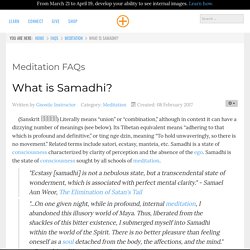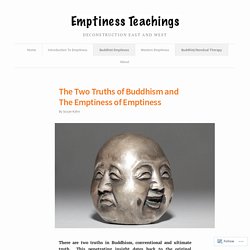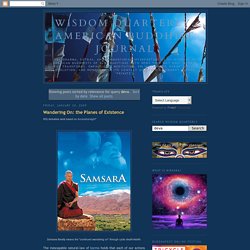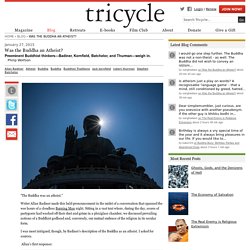

What is Samadhi? (Sanskrit समाधि) Literally means “union” or “combination,” although in context it can have a dizzying number of meanings (see below).

Its Tibetan equivalent means “adhering to that which is profound and definitive,” or ting nge dzin, meaning “To hold unwaveringly, so there is no movement.” Jataka tales. Bhutanese painted thangka of the Jātakas, 18th-19th Century, Phajoding Gonpa, Thimphu, Bhutan Thangka of Buddha with the One Hundred Jataka Tales in the background, Tibet, 13th-14th century.

The Jātaka tales are a voluminous body of literature native to India concerning the previous births of Gautama Buddha in both human and animal form. The future Buddha may appear as a king, an outcast, a god, an elephant—but, in whatever form, he exhibits some virtue that the tale thereby inculcates.[1] Often, Jātaka tales include an extensive cast of characters who interact and get into various kinds of trouble - whereupon the Buddha character intervenes to resolve all the problems and bring about a happy ending. In Theravada Buddhism, the Jātakas are a textual division of the Pāli Canon, included in the Khuddaka Nikaya of the Sutta Pitaka.
The term Jātaka may also refer to a traditional commentary on this book. History[edit] According to A. Contents[edit] Jātaka stupas[edit] Apocrypha[edit] Buddhism and the God-idea. Do Buddhists believe in a god?

No, we do not. There are several reasons for this. The Buddha, like modern sociologists and psychologists, believed that religious ideas and especially the god idea have their origins in fear. The Buddha says: Gripped by fear people go to sacred mountains, sacred groves, sacred trees and shrines. Verses of Protection. The Two Truths of Buddhism and The Emptiness of Emptiness. There are two truths in Buddhism, conventional and ultimate truth.

This penetrating insight dates back to the original Buddha. Understanding the two truths and the relationship between them is vital in seeing through the illusion of inherent existence and realizing emptiness or Śūnyatā.~ Nagarjuna’s philosophy of the Middle Way or Mahyamaka school of Buddhism shows how the two truths are different and yet despite this difference are critically the same. An understanding of this paradox is a journey of remarkable insight and clarity. Nagarjuna’s doctrine of the emptiness of emptiness is imperative on this account. ~The references used for this article focused on the brilliant works of Jay Garfield, Professor of Philosophy, Buddhist scholar and translator. ~ Conventional truth involves our everyday experience and understanding of the way the phenomenal world appears and functions. ~“Whatever is dependently co-arisen That is explained to be emptiness. Nagarjuna. Mahayana Buddhism Origins, Mahayana Buddhism History, Mahayana Buddhism Beliefs.
Mahayana Buddhism, also known as the Great Vehicle, is the form of Buddhism prominent in North Asia, including China, Mongolia, Tibet, Korea, and Japan.

Arising out of schisms—about both doctrine and monastic rules—within Indian Buddhism in the first century C.E., the Great Vehicle considers itself a more authentic version of the Buddha's teachings. American Buddhist Journal: Search results for deva. Samsara literally means the "continued wandering on" through cyclic death/rebirth.

The inescapable natural-law of karma holds that each of our actions — whether of body, speech, or mind — has consequences in line with the skillfulness or unskillfulness of that action. We can often witness this process firsthand in our own lives, even if the effects may not be immediately apparent. But the Buddha also taught that our intentions and actions (again whether mental, verbal, or physical) have effects that extend far beyond our present life, determining the quality of rebirth we can expect after death: Actions which are wholesome and skillful destine one for a favorable rebirth.
Deeds which are unwholesome and unskillful lead to an unpleasant rebirth. Buddhist Monsters – Inside and Out. While there is no shortage of serene and benevolent buddhas, Buddhist folklore abounds with hell-raising zombies, vampires, ghouls, and ogres.

But they’re not just the stuff of myth and legends. Depending on whom you ask, these ferocious monsters are thought to be as real as you or me, or serve as potent symbols of our less enlightened sides. Since reincarnation sits at the heart of Buddhist cosmology, we are never far from becoming the monsters we fear. In tantric traditions, practitioners are taught that subjugating outer demons is really about taming inner ones.
As you reflect on the creatures rounded up in this cross-cultural compendium, you’ll see that monsters do more than scare people into acting more virtuously. Pretas: Ghosts Who Just Can’t Get Enough Many Buddhist monasteries have a wheel at their entrances that is inscribed with the six realms of worldly existence. American Buddhist Journal: Search results for space. Thus have I heard.

On one occasion the Blessed One (the Buddha) was staying at Savatthi in the Eastern Temple, the monastery of Migara's mother. Then in the evening, Ven. Ananda, coming out of [meditative] seclusion, went to the Blessed One, bowed, and sat respectfully to one side. As he was sitting there, he said to the [Buddha]: "On one occasion, when the Blessed One was staying among [his family] the Shakyans in a Shakyan town [far west of India] named Nagaraka, there -- face-to-face with the Blessed One -- I heard this, face-to-face I learned this: "'I now remain fully in a dwelling of emptiness.' NOTE: This discourse deals with the "four immaterial meditative absorptions" or arupa jhanas beyond the "fine material (rupa) sphere" and its four levels of absorption. Was the Buddha an Atheist? "The Buddha was an atheist.

" Writer Allan Badiner made this bald pronouncement in the midst of a conversation that spanned the wee hours of a cloudless Burning Man night. Sitting in a vast tent where, during the day, scores of partygoers had washed off their dust and grime in a plexiglass chamber, we discussed prevailing notions of a Buddhist godhead and, conversely, our mutual embrace of the religion in its secular form. I was most intrigued, though, by Badiner’s description of the Buddha as an atheist. I asked for sources. Allan’s first response: I would need time to do it, but there are passages from the Tripitaka that strongly indicate that the Buddha denied the existence of a creator god. I responded with enthusiasm and persistence: "I like nontheist—thanks—but do send me the citation when you can. " He did: American Buddhist Journal: Search results for khema.
Just as there were two foremost disciples in the order of monks (Sariputra and Maha Moggallana), likewise the Buddha named two women as foremost amongst nuns, namely Khema and Uppalavanna.

Khema -- whose name means well-settled, composed, security, a synonym for nirvana -- was "foremost in wisdom. " She belonged to a royal family from Magadha, the middle country where Siddhartha went in search of enlightenment. American Buddhist Journal: Search results for nirvana. The Buddha as depicted in Thailand (Ursulainbkk/Flickr.com) Nibbana by Bhikkhu Bodhi, edited by Wisdom Quarterly The Buddha says that he teaches only dukkha and the cessation of dukkha. Dukkha, or "suffering," is an ancient term that includes all unpleasant experience from slight agitation to intense agony. American Buddhist Journal: Search results for converted to all religions. Buddhism in a Nutshell first appeared in 1933. Since then several editions have been published by various philanthropists for free distribution. For a fuller exposition of the subjects dealt with here, readers may refer to the revised and enlarged edition of The Buddha and His Teachings published in 1980. — Ven.
Guide To Buddhism A To Z. Buddhist Inspirations & News » Are Manifestations & Mediums Of Bodhisattvas & Buddhas Around? We should respect all beings, even helpful humans, gods and ghosts. However, Buddhists only take refuge in the perfect Buddhas, Dharma and Aryasangha. An interestingly phrased question arose recently – ‘Why do mediums not get any Buddha to answer their devotees’ questions?’ Before there is further confusion, we should be clear that the use of mediums is not a Buddhist practice. A Fistful of Sand. Experience of Samadhi Shankman.